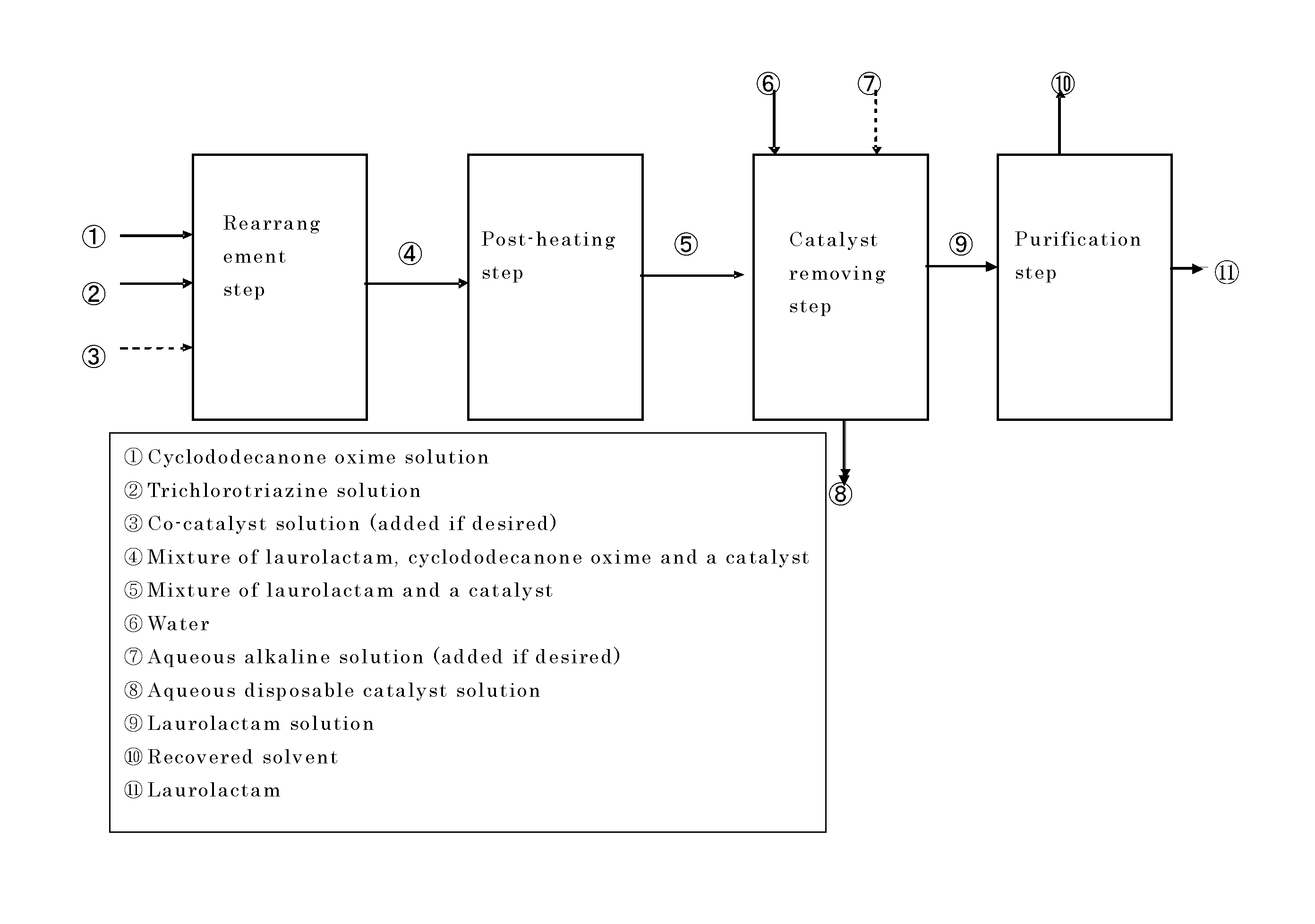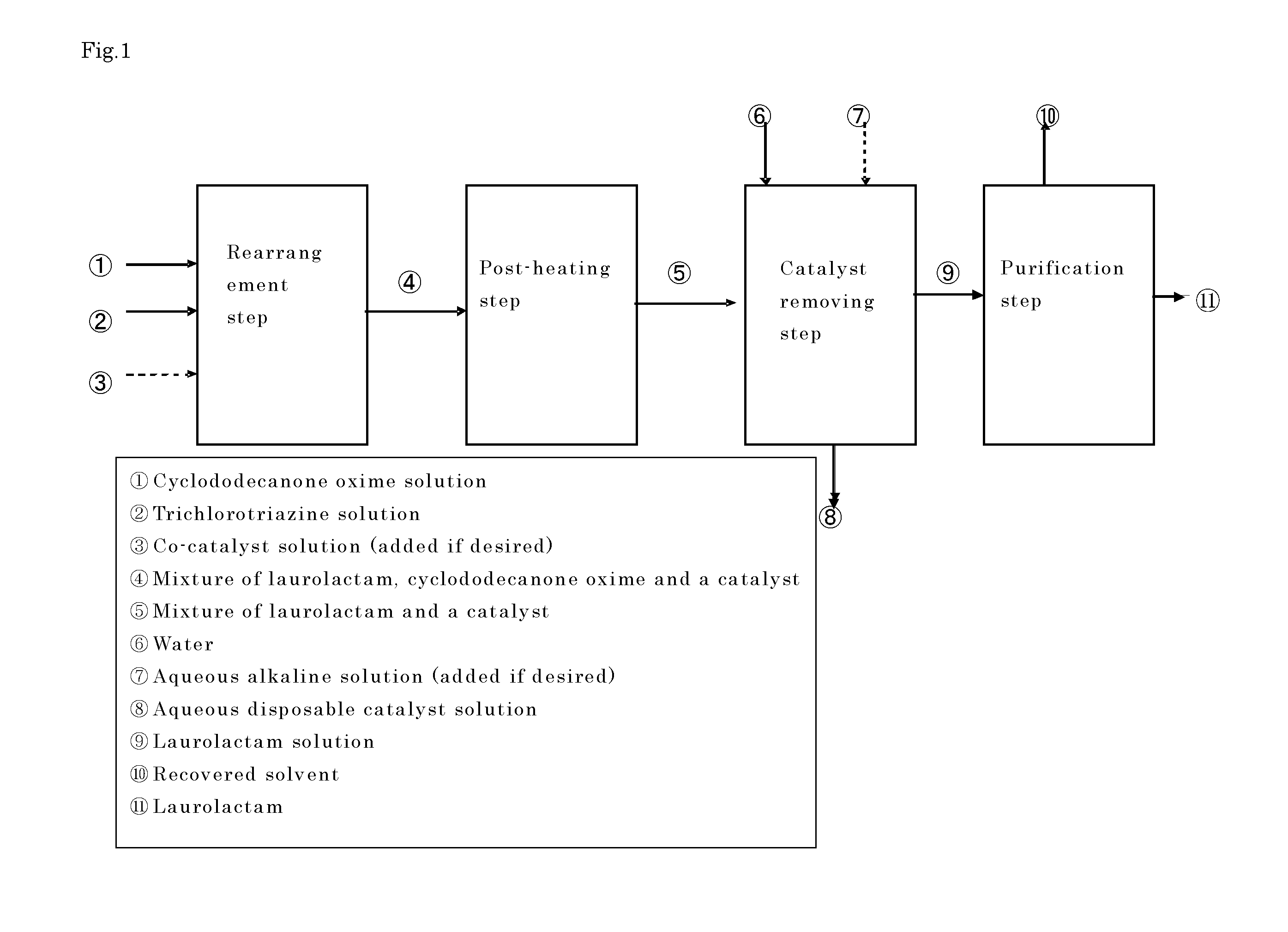Process for producing laurolactam
a technology of laurolactam and process, which is applied in the field of process for producing laurolactam, can solve the problems of large amount of treatment facilities and energy, large processing facilities, and complex process, and achieve the effect of high selective production of laurolactam and higher yield
- Summary
- Abstract
- Description
- Claims
- Application Information
AI Technical Summary
Benefits of technology
Problems solved by technology
Method used
Image
Examples
reference example 1
Production of Cyclododecanone Oxime
[0063]Into a pillow type first reactor for oxime formation with a 30 liter liquid phase zone which was internally divided into four chambers each of which was equipped with an agitating blade were fed a 15% by weight aqueous solution of hydroxylamine sulfate (Wako Pure Chemical Industries, Ltd.) at 1.5 kg / h and an oil phase from a second reactor for oxime formation. After adjusting a reaction temperature to 95° C., 25% by weight of ammonia water was fed into each chamber at 32 g / h to carry out the oxime-forming reaction. To the reaction solution was added toluene at 0.5 kg / h and the phases was separated to obtain an oil phase consisting of cyclododecanone oxime and toluene. The aqueous phase was fed to the second reactor for oxime formation. Into the second reactor for oxime formation, which was a pillow type reactor with a 15 liter volume which was internally divided into four chambers, were fed the aqueous phase of the above oxime-forming reactio...
reference example 2
Drying of Cyclododecanone Oxime
[0066]Cyclododecanone oxime used in Examples 1 to 27 and Comparative Example 1 to 13 was prepared as follows.
[0067]In 10 liter evaporator was placed 4 kg of the solution of cyclododecanone oxime in toluene obtained in Reference Example 1, and toluene was evaporated to obtain 790 g of cyclododecanone oxime. The resulting cyclododecanone oxime was placed in a vacuum dryer and dried at 120° C. under a reduced pressure of 150 Pa for 24 hours to give 740 g of dehydrated cyclododecanone oxime. A moisture content was determined in a dry box by a Karl Fischer type moisture measuring instrument to be 15 ppm.
example 1
[0068]In 50 g of acetonitrile (Wako Pure Chemical Industries, Ltd.) were dissolved 10 g of dehydrated cyclododecanone oxime prepared in Reference Example 2, 0.467 g of trichlorotriazine (Wako Pure Chemical Industries, Ltd.) (cyclododecanone oxime concentration: 16.6% by weight; trichlorotriazine / cyclododecanone oxime (mol / mol): 0.05) to prepare a reactant solution. Moisture content measurement showed acetonitrile and the reactant material solution contained moisture in 450 ppm and 375 ppm, respectively. A water / trichlorotriazine ratio in the reactant material solution was 0.50. Here, preparation of the reactant solution and moisture measurement in the solvent were conducted in a dry box. The reactant solution in the closed vessel was removed from the dry box and heated with stirring under nitrogen atmosphere in an oil bath, and at 80° C. the reaction was conducted for 2 hours and was analyzed by gas chromatography (hereinafter, similar analysis was conducted in Examples and Comparat...
PUM
| Property | Measurement | Unit |
|---|---|---|
| melting point | aaaaa | aaaaa |
| temperature | aaaaa | aaaaa |
| boiling point | aaaaa | aaaaa |
Abstract
Description
Claims
Application Information
 Login to View More
Login to View More - R&D
- Intellectual Property
- Life Sciences
- Materials
- Tech Scout
- Unparalleled Data Quality
- Higher Quality Content
- 60% Fewer Hallucinations
Browse by: Latest US Patents, China's latest patents, Technical Efficacy Thesaurus, Application Domain, Technology Topic, Popular Technical Reports.
© 2025 PatSnap. All rights reserved.Legal|Privacy policy|Modern Slavery Act Transparency Statement|Sitemap|About US| Contact US: help@patsnap.com


